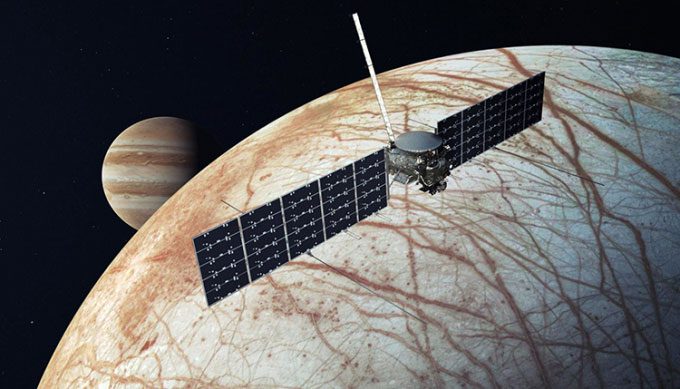After completing its mission, the Europa Clipper spacecraft may “self-destruct” by crashing into Jupiter’s moon Ganymede for scientific purposes.
Deep space missions are often one-way trips. The Europa Clipper spacecraft from NASA is no exception. After studying Jupiter’s moon Europa, the spacecraft will “self-destruct.” However, instead of crashing into Jupiter as previously planned, it may collide with either Ganymede or Callisto, according to scientist Bob Pappalardo during a meeting on June 15.

Illustration of the Europa Clipper spacecraft. (Photo: NASA/JPL-Caltech)
Changing the impact location is one of the recent budget-saving measures implemented for the Europa Clipper mission. Crashing into Ganymede or Callisto would be more efficient and fuel-saving, according to Pappalardo. Another measure is reducing the spacecraft’s flybys of Europa from 53 to 49.
Ganymede—the largest moon in the Solar System—has a higher likelihood of being selected due to its scientific benefits. A collision of Europa Clipper with Ganymede instead of Callisto or Jupiter could complement the future JUICE mission, Pappalardo stated. The JUICE mission, developed by the European Space Agency, is expected to launch in 2023. The spacecraft in this mission will study three icy moons of Jupiter, with Ganymede as the primary target.
“If the JUICE spacecraft is still in orbit around Ganymede at the time of the Clipper’s self-destruction, JUICE’s instruments could observe the impact and learn about Ganymede’s characteristics,” Pappalardo said.
Many spacecraft have been deliberately destroyed by crashing into celestial bodies or disintegrating in the atmosphere, often to protect potentially habitable environments. Additionally, such self-destruction can also serve as a research mission; for example, NASA’s Deep Impact spacecraft crashed into a comet so scientists could study its composition.
In the case of Europa Clipper, the self-destruction aims to protect Europa. Like Europa, Ganymede is believed to have a subsurface ocean, meaning that this moon could harbor ingredients suitable for life. However, the Europa Clipper team has worked with NASA’s Planetary Protection Office and determined that the risk of the spacecraft contaminating this water is minimal due to Ganymede’s thick ice shell and lithosphere.
As the Europa Clipper continues its research on Jupiter and its moons, the spacecraft’s self-destruction site may change again based on new information. But for now, it seems that Ganymede will face a significant impact.
- Poseidon: The Russian weapon compared to a “doomsday machine” by the West, capable of causing a 90m high tsunami
- Etruscans: The ancient civilization that is brilliant yet mysterious to scientists
- The breathtaking natural wonders of the world that have permanently disappeared in just the past 10 years





















































